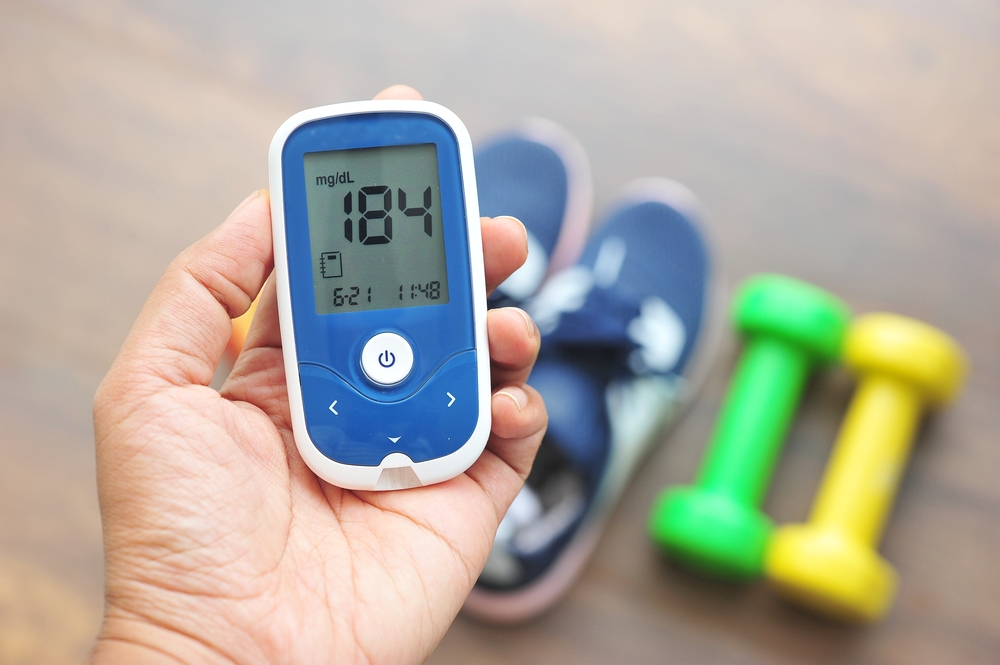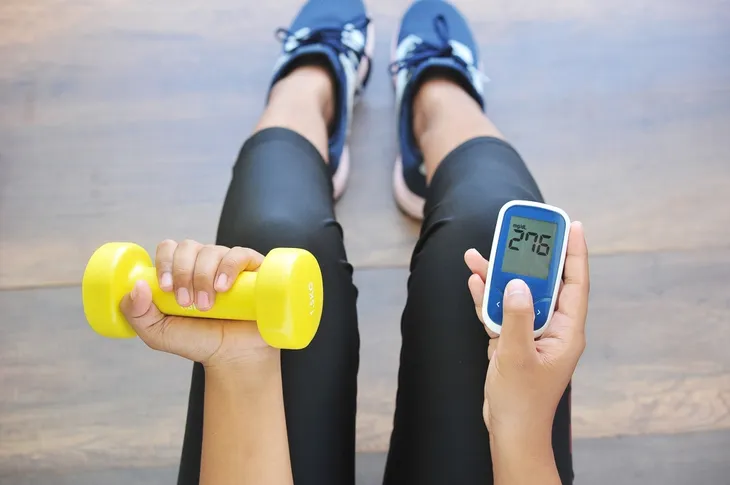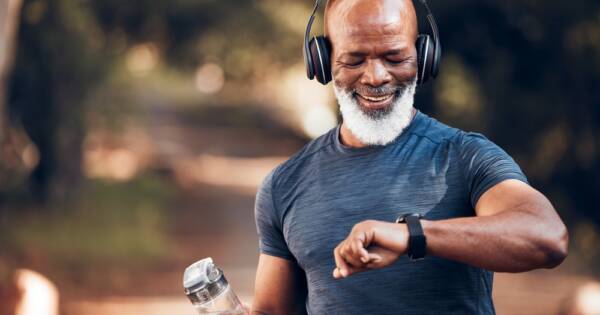Do you have type 1 or type 2 diabetes? If so, you’re not alone. In the United States alone there are more than 30 million people — around 9.4-percent of the population — who live with the disorders. One way to manage this disease is to adopt a regular physical exercise routine. Movement helps you control your symptoms and prevents your condition from damaging internal organs. As the saying goes, sitting is the new smoking.
Take a Walk
If you head to the gym, you might feel intimidated by the many machines, such as treadmills, stair masters, stationary bikes, rowers and more. Instead of buying a membership, take a walk around your block. A stroll is simple, plus all you need is a good pair of shoes. If you like to listen to tunes while you exercise, bring along your MP3 player and some headphones.
Walking is an aerobic activity that raises the heart rate. According to experts, this type of exercise can lower resistance to the hormone that regulates glucose and hemoglobin A1c levels, a number that indicates your average blood sugar over the past two to three months. Plus, people with diabetes who walk at least two hours per week are less likely to have heart disease compared to sedentary counterparts. You can cut your risk even more by exercising for three to four hours.
Try Strength Training
Strength training, also called resistance training, helps you build muscle. You can perform this task with handheld weights, stretch bands or your own body. If you don’t feel comfortable at a fitness center, you can do this type of training in your home or backyard. As a bonus, this activity will help you with other everyday tasks, such as climbing stairs, lifting heavy objects and walking.
Studies show that strength training is as effective as aerobic exercise when it comes to improving how your body uses the hormone that regulates glucose in the blood. For those with diabetes, it can also aid in blood sugar control and weight loss. Similar to other types of physical activity, resistance training can lower your risk of heart disease.
Join a Yoga Class
Do you often feel down about your condition? You may find it hard to get out of bed or work up the motivation to get outside. Studies show that taking a yoga class — or following along in your own home — can help. For those with type 2 diabetes, research reveals physical activity leads to fewer depressive symptoms, no matter if you work out once a week or five times.
If you’re a beginner, start with some simple poses you can strike in your living room. To attempt the mountain pose, for instance, you’ll want to keep your heels on the floor and your body straight. Engage your leg muscles as much as possible, and don’t forget to breathe.
Keep a Log
Exercise, no matter the type, is a key factor in preventing cancer. Unfortunately, those with diabetes, especially type 2, are at a higher risk of developing various cancers, including one of the most dangerous types of cancer you can develop — pancreatic cancer. To ensure you’re getting your sweat on adequately throughout the week, keep a log of your physical activity. If you hit the gym, mark it down, along with the type of exercise you performed.
If you miss a day, don’t fret. Everybody needs a break, even those in peak condition. Along with exercise, you should also use this log to track your blood sugar levels before and after the activity. Seeing a healthy trend may help motivate you on days when you don’t feel like getting out of bed.
Always Stay Hydrated
Everyone who exercises needs to drink plenty of water. If you have type 1 or type 2 diabetes, dehydration is often associated with erratic blood sugar levels and heat stroke. To stay safe, bring along a bottle wherever you go, and remember to take sips before, during and after any activity. Look for a clear container with measurements along the side so you can track how much you drink throughout the day.
Sometimes, it can be hard to tell if your body needs water. Some common symptoms of dehydration include headaches, dry mouth, thirst, dizziness and dark-colored urine. If this condition becomes severe, your blood pressure can drop, your heartbeat may speed up, and you may start to feel confused and lethargic.
Perform a Warm Up
Exercise is great for your body. If you jump into it too quickly, however, you can stress your body out and injure your muscles. Before you go for a jog or jump in the pool, perform a warm up routine. Stretch out your muscles by doing lunges and lifting your arms high into the air. You can also loosen up your back with an exercise ball.
According to experts, warming up before physical activity will help prepare your heart, lungs and muscles for the exertion that’s to come. Remember to keep it short and light. A 15-minute routine before you jump into the main event is enough. Many people also like to complete a cool down after they exercise, helping your beating heart get back to its normal rhythm.
Go for a Swim
Swimming, an aerobic exercise, is great for those with diabetes because it doesn’t put unnecessary strain on your joints. A few laps around the pool will help you burn calories, tone your muscles, and lower blood pressure and cholesterol. This physical exercise can also help you control your glucose levels if you keep a consistent pace.
Before you hop in the water, be sure to apply sunscreen to prevent burns to your skin. You should also bring along a snack to ensure you maintain your sugar levels. Remember to start slow with this exercise, and don’t push yourself. Gradually, you’ll be able to increase your strength and swim faster. If you’re tired of the pool, visit the beach or a nearby lake.
Exercise in Increments
If you try to jog for 60-minutes straight, you may find yourself huffing and puffing, unable to go on. Instead of pushing yourself, which can be detrimental to your health, try to break up physical activity into manageable increments. Pick a few times during the day, such as before work in the morning, during your lunch break and when you get home.
For instance, when you wake up, try a 15-minute yoga routine. In the afternoon, go for a brisk walk around your workplace. At the end of the day, swim a few laps in the pool. Many people think you can’t get fit and lose weight if you perform short workouts, but that’s not the case. Short bursts of exercise generally provide the same health and fitness benefits as those completed in one uninterrupted session.
Practice Tai Chi
For those with diabetes, tai chi is an excellent way to start your journey toward improved health. This practice is a Chinese martial art that combines diaphragmatic breathing with gentle movements. It’s considered a moderate exercise, ideal for those who aren’t used to breaking a sweat every day.
According to studies, those with type 2 diabetes can benefit significantly from tai chi, as the exercise improves blood glucose levels and immune system response. While diabetes causes chronic inflammation, experts believe this exercise can improve blood glucose metabolism, prompting a decrease in the body’s inflammatory response. As a bonus, those who perform this martial art tend to lose weight.
Dance to Music
Dancing is a great way to increase your heartbeat, work up a sweat and burn calories. As with any exercise, it’s essential to stop if you injure yourself or feel any pain. High blood sugar levels prevent healing, meaning those with diabetes can suffer consequences from exercising when they don’t feel well. Being a dancer with this disorder takes extra care and preparation, but it’s still possible.
Dancing is something you can do in the comfort of your own home. Before you begin, create a playlist with some of your favorite tunes, hits that make you want to get up and move. After a workout, eat a snack with both complex carbohydrates and protein to refuel. If you don’t eat enough before or after a workout, you could be at risk of hypoglycemia.
Find a Friend
It can be hard to work up the motivation to work out, especially when you’re doing so alone. To maintain your commitment, look for an exercise buddy you can sweat with. According to one study, 95-percent of people who start a weight-loss program with friends complete it, compared to 75-percent who choose to work out alone.
Look for activities you and your friend can do together. For instance, you can try speed walking to a set finish line, seeing who can reach the end first. Break out some jump ropes and determine who can hop the most. You can also try some video games that encourage exercise, such as virtual tennis or baseball. Once finished, grab a healthy snack together, like a fruit-packed smoothie.
Hop on a Bike
Cycling is a great physical activity for those with diabetes, as it’s easy on the joints and requires less effort than running. Plus, a bicycle is an excellent way to get around town. According to experts, people with diabetes who cycle see a reduction in pressure through their feet and a decreased heart rate. Additionally, a mere 20 minutes of pedaling can lower blood glucose levels.
During your rides, be sure to watch your levels, stay hydrated and refuel if necessary. Bring along a snack, such as a protein bar, in case you need it. After a hard ride, it’s essential to restore your carbs and proteins. If you don’t feel like cycling outside, you can always ride a stationary bike at home or the gym.
Remember, no matter what type of physical activity you choose, it’s crucial to ID yourself. Wear a necklace or bracelet that identifies you as someone with diabetes. If an emergency should occur, those around you will know the best treatment option to get you the help you need.
Exercising When You Have Diabetes
If you’re living with type 1 or type 2 diabetes, exercise is essential for managing your condition. However, getting off the couch and into your gym clothes can seem like an insurmountable task. Don’t relegate yourself to a lifetime of unhealthy habits. Instead, discover types of exercise that work for you. From taking a walk to staying hydrated, you can lose weight, control your blood sugar levels and feel amazing.
















